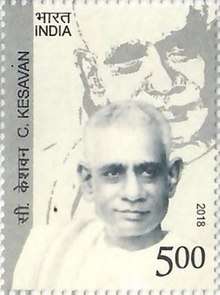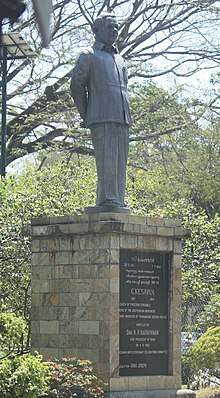C. Kesavan
C. Kesavan (23 May 1891 – 7 July 1969) was the Chief Minister of Travancore-Cochin during 1950–1952.[1]
C. Kesavan | |
|---|---|
 Kesavan on a 2018 stamp of India.jpg | |
| Personal details | |
| Born | 23 May 1891 Mayyanad, Kerala, India |
| Died | 7 July 1969 (aged 78) Mayyanad, Kerala, India |
He was born in 1891 in the village of Mayyanad, near Kollam in the then princely state of Travancore.[1] For some time he worked as a teacher and then took a law degree from Thiruvananthapuram and started practice in Kollam.
Kesavan was influenced by the work of Padmanabhan Palpu, the social reform campaigner who was a member of the backward Ezhava community and a founder of the Sree Narayana Dharma Paripalana association where he later rose to the general secretary post.[2] He became an activist for the Ezhava caste, seeking an improved socio-economic position for them, and in the 1930s he suggested that they should abandon Hinduism. Thus he was an atheist.[1] C. Kesavan was influenced by the teachings of Sree Narayana Guru, Gandhiji and Karl Marx. He worked for temperance and eradication of untouchability and served as General Secretary of SNDP Yogam.
From 1933, C. Kesavan was one of the prominent leaders of Abstention movement or Nivarthana Prakshobham in Travancore of present-day Kerala.[3] Because of a speech he made at a public meeting in Kozhencherry he was arrested on 7 June 1935, tried for sedition, and sentenced to two years imprisonment. In
Kesavan took an active part in organizing Travancore State Congress and became a member of its working Committee. During the agitation for responsible government in Travancore, he was arrested several times. During Quit India Movement in 1942, Kesavan was sentenced to one year simple imprisonment and was released on 19 July 1943. After Independence, Kesavan was elected to Travancore Assembly and became a member of the first cabinet headed by Pattom Thanu Pillai, but resigned after few months. Kesavan became Chief Minister of the erstwhile Travancore-Cochin (Thiruvithamkoor-Kochi) state in 1951 and was elected to State Assembly in 1952.[4] C. Kesavan was considered to be one of the Triumvirate of Travancore (Thiruvithaamkoor) State Congress leadership, the other two being Pattom A. Thanu Pillai and T.M. Varghese.
Kesavan wrote an incomplete autobiography, Jeevitha-Samaram, consisting of two volumes that described his life up to the time of his political prominence. A third volume was planned to cover that later period but was unwritten at the time of his death. The work combined the story of his own life with a wider narrative concerning the plight of the Ezhava caste of which he was a member. Udaya Kumar says that his "early memories are tinged with two lines of injustice: the discrimination he suffered as an Ezhava boy on the streets and other public places, where he was forced to defer to upper-caste people, and the unjust exercise of authority by the elders and the upper sub-divisions within the Ezhava caste".[1]

The Kollam Corporation Town Hall was named the C. Kesavan Memorial Municipal Town Hall in Kesavan's memory. It is a decades-old building situated on the National Highway passing through the Kollam Cantonment.[5][1] The building is now one of the main venues for several cultural events and meetings.[6][7] He was instrumental in the starting of Medical College at Thiruvananthapuram. His presence is recorded in the batch photo of first batch of doctors from the Government Medical College, Thiruvananthapuram.[8] He has also worked for establishing a Govt Hospital in his home town Mayyanad. Which functioned well in its helm days and later shrunk to a health center.
As Chief Minister
C. Kesavan sworn in as Chief Minister of Travancore-Cochin on 3 March 1951. T.K. Narayana Pillai and A.J. John were the ministers. Both the ministers resigned in September 1951. New ministers sworn in were : K.M. Kora (Finance & Food), G. Chandrasekhara Pillai (PWD), L.M. Pylee (Education & Revenue), P.K. Krishnankutty Menon (Industries & Labour). After the declaration of general election of 1952, C. Kesavan ministry relinquished power on 12 March 1952. The historic Land Reforms Bill was piloted by C. Kesavan, but failed to pass through. The Trivandrum Medical College was opened by Prime Minister Jawaharlal Nehru during C. Kesavan's tenure.
A controversial statement made by C. Kesavan before he becoming Travancore -Kochi CM is history. When the fire broke out in Sabarimala, during May 1950 in the following months C. Kesavan, in his characteristic frankness said: "If a temple is destroyed that much of religious fanaticism will go off."[9][10]
Personal life
C.Kesavan was married to Vasanthi who was the daughter of C. V. Kunhiraman, the founder of Kerala Kaumudi. His son K. R. Bhadran died in an Air India Dakota plane crash near Mettupalayam in December 1950.[11] At that time Kesavan was living in Ross House at Thiruvananthapuram which was widely considered as a haunted house and bad omen among political class of Kerala.[12]
See also
References
| Wikimedia Commons has media related to C. Kesavan. |
- Kumar, Udaya (2009). "Subjects of New Lives". In Ray, Bharati (ed.). Different Types of History. Pearson Education India. pp. 322–323. ISBN 9788131718186.
- Kumar, Udaya (2009). "Subjects of New Lives". In Ray, Bharati (ed.). Different Types of History. Pearson Education India. p. 326. ISBN 9788131718186.
- "ABSTENTION MOVEMENT". ckesavan.com. Retrieved 10 July 2019.
- stateofkerala.in. "Kerala State - Everything about Kerala". www.stateofkerala.in. Retrieved 10 July 2019.
- "C. Kesavan's statue unveiled in Kollam". The Hindu. 14 June 2008. Retrieved 4 July 2017.
- "New rent for town hall to be ratified today". The Hindu. 16 June 2007. Retrieved 4 July 2017.
- "A bridge to bypass choking traffic". The Hindu. 19 January 2014. Retrieved 4 July 2017.
- "നിവർത്തന പ്രക്ഷോഭ നായകന്റെ ഓർമയിൽ ജന്മനാട്". ManoramaOnline (in Malayalam). Retrieved 10 July 2019.
- "Mystery fire at Sabarimala in 1950". OnManorama. Retrieved 10 July 2019.
- "THE CHIEF MINISTER". ckesavan.com. Retrieved 10 July 2019.
- "planecrash - purnanprabhu". sites.google.com. Retrieved 10 July 2019.
- 7 March; December 15, 2014 ISSUE DATE; February 24, 1978UPDATED; Ist, 2015 16:48. "The haunted house". India Today. Retrieved 10 July 2019.CS1 maint: numeric names: authors list (link)
| Political offices | ||
|---|---|---|
| Preceded by Parur T. K. Narayana Pillai |
Chief minister of Travancore-Cochin 1951–1952 |
Succeeded by A. J. John, Anaparambil |